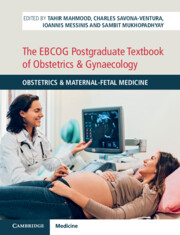Book contents
- The EBCOG Postgraduate Textbook of Obstetrics & Gynaecology
- The EBCOG Postgraduate Textbook of Obstetrics & Gynaecology
- Copyright page
- Dedication
- Contents
- Contributors
- Preface
- Section 1 Basic Sciences in Obstetrics
- Section 2 Early Pregnancy Problems
- Section 3 Fetal Medicine
- Chapter 10 Pre-Conception Care
- Chapter 11 Ultrasound Scanning in the First Trimester of Pregnancy
- Chapter 12 Prenatal Diagnostic Techniques
- Chapter 13 Invasive Fetal Therapies
- Chapter 14 Normal Fetal Growth and Fetal Macrosomia
- Chapter 15 Fetal Haemolysis
- Chapter 16 Antenatal Care of a Normal Pregnancy
- Chapter 17 Screening for High-Risk Pregnancy
- Chapter 18 Multiple Pregnancy
- Chapter 19 Intrauterine Growth Restriction
- Chapter 20 Fetal Origin of Adult Disease
- Chapter 21 Antepartum Haemorrhage
- Chapter 22 Obstetric Care of Migrant Populations
- Chapter 23 Care of Women with Previous Adverse Pregnancy Outcome
- Chapter 24 Preterm Prelabour Rupture of Membranes
- Section 4 Maternal Medicine
- Section 5 Intrapartum Care
- Section 6 Neonatal Problems
- Section 7 Placenta
- Section 8 Public Health Issues in Obstetrics
- Section 9 Co-Morbidities during Pregnancy
- Index
- Plate Section (PDF Only)
- References
Chapter 23 - Care of Women with Previous Adverse Pregnancy Outcome
from Section 3 - Fetal Medicine
Published online by Cambridge University Press: 20 November 2021
- The EBCOG Postgraduate Textbook of Obstetrics & Gynaecology
- The EBCOG Postgraduate Textbook of Obstetrics & Gynaecology
- Copyright page
- Dedication
- Contents
- Contributors
- Preface
- Section 1 Basic Sciences in Obstetrics
- Section 2 Early Pregnancy Problems
- Section 3 Fetal Medicine
- Chapter 10 Pre-Conception Care
- Chapter 11 Ultrasound Scanning in the First Trimester of Pregnancy
- Chapter 12 Prenatal Diagnostic Techniques
- Chapter 13 Invasive Fetal Therapies
- Chapter 14 Normal Fetal Growth and Fetal Macrosomia
- Chapter 15 Fetal Haemolysis
- Chapter 16 Antenatal Care of a Normal Pregnancy
- Chapter 17 Screening for High-Risk Pregnancy
- Chapter 18 Multiple Pregnancy
- Chapter 19 Intrauterine Growth Restriction
- Chapter 20 Fetal Origin of Adult Disease
- Chapter 21 Antepartum Haemorrhage
- Chapter 22 Obstetric Care of Migrant Populations
- Chapter 23 Care of Women with Previous Adverse Pregnancy Outcome
- Chapter 24 Preterm Prelabour Rupture of Membranes
- Section 4 Maternal Medicine
- Section 5 Intrapartum Care
- Section 6 Neonatal Problems
- Section 7 Placenta
- Section 8 Public Health Issues in Obstetrics
- Section 9 Co-Morbidities during Pregnancy
- Index
- Plate Section (PDF Only)
- References
Summary
Pregnancies with previous adverse outcomes present unique challenges to healthcare professionals caring for them. They are a heterogenous group that includes adverse outcomes for mother, fetus and/or baby. Adverse outcome of pregnancy may include miscarriage, stillbirth, preterm delivery, fetal growth restriction, congenital anomalies, intrapartum stillbirths, birth asphyxia, birth trauma, neonatal morbidity and neonatal mortality. These could be a result of antenatally known factors, intrapartum events or neonatal complications. Adverse pregnancy events may have long-term implications for the health of the surviving babies/children and mothers.
- Type
- Chapter
- Information
- The EBCOG Postgraduate Textbook of Obstetrics & GynaecologyObstetrics & Maternal-Fetal Medicine, pp. 190 - 196Publisher: Cambridge University PressPrint publication year: 2021

